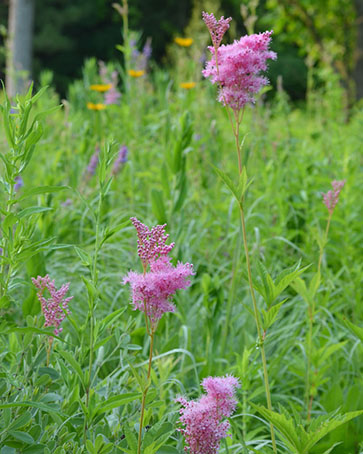Queen of the Prairie
 Filipendula rubra
Filipendula rubra
See All Native Plants for Sale
Introduction
Queen of the Prairie heralds fragile sprays of tiny pink buds in early summer. These pearlescent clusters burgeon out and burst open from bottom to top in an abundance of little flowers attended by a fanfare of filaments. Floating above the surrounding plants, the cotton candy-colored plumes look exactly like the favorite carnival food. Color saturation often increases as the flowers mature, ranging from the faintest of pinks to rich, regal magentas.
These blooms ascend from lovely, deeply lobed foliage that provide an attractive backdrop after the showstopping flowers are spent. Deadheading does not signal for more flower production, so enjoy them while they last! The stems can sometimes be a ruddy red.
Filipendula rubra is the crowning jewel of any consistently moist site – and requires a great deal of territory to reign over. Each Queen of the Prairie plant can grow quite large and will colonize in optimal sites. This plant prefers full sun, but appreciates some shade in particularly hot, dry climates; stems may be weak and tend to lean in less than sunny conditions. Insufficient water, especially in direct sun, can cause crispy leaves and damage the plant. If experiencing drought conditions, prune the stem back severely to redirect energy into the roots and encourage new growth.
Queen of the Prairie produces an abundance of pollen for native bees and other pollinators, but the myriad of flowers do not provide any nectar. It is considered deer-resistant, especially once established. This one-of-a-kind native plant is considered rare throughout much of its historic range.
Life Cycle
Perennial
Sun Exposure
Full
Soil Moisture
Wet, Medium-Wet
Height
5 Feet
Bloom Time
June, July, August
Bloom Color
Pink